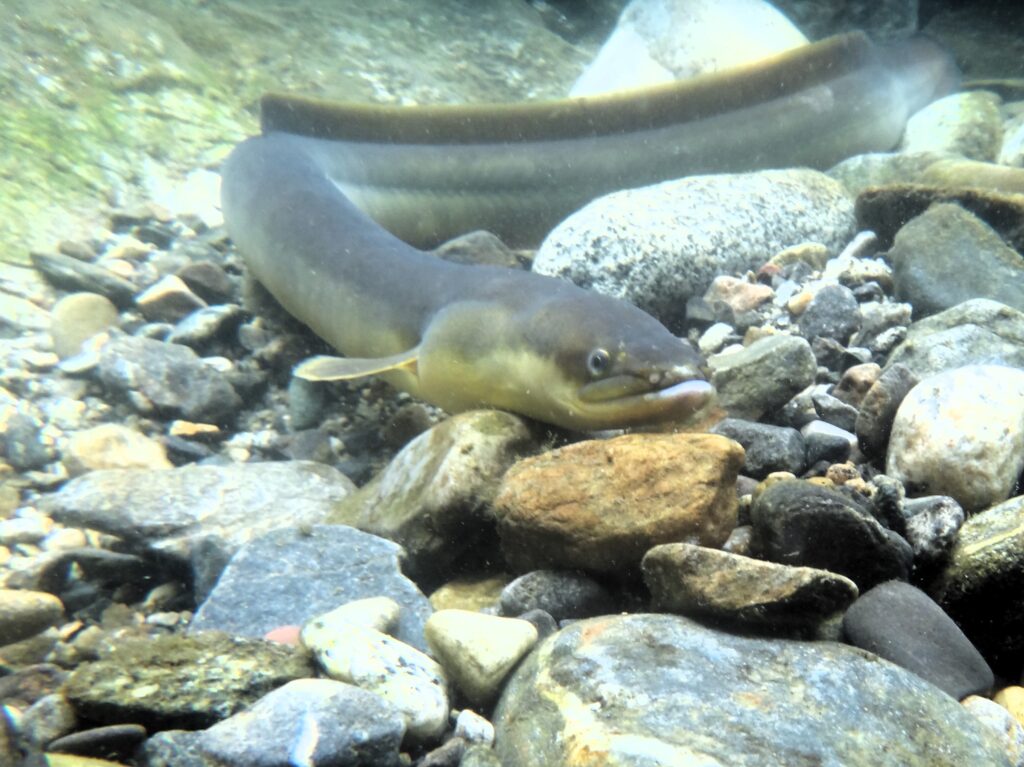There’s a saying that Japanese children, when hearing the word “fish,” would picture not a swimming form but a sliced fillet. This phrase mocks the reality of children who have only ever seen fish on their dinner plates. I used to think to myself, “That might be true, what a shame.”
However, this was not just an issue concerning others. Indeed, in the case of the Japanese eel, Unagi, I never actually encountered one in nature until I was an adult. In other words, for me, Unagi was solely associated with the delicious grilled dish known as Kabayaki.
So, what kind of fish is the Japanese eel? Eels belong to the order Anguilliformes and the family Anguillidae, with the scientific name “Anguilla japonica.” As many people imagine, this fish has a long, slender body with a dark brown to black color. Adult eels are typically around 40cm to 1m in size and have a slippery body. Unlike ordinary fish, eels can move backward and easily escape from containers.

Anguilla japonica is mainly found in East Asia, particularly in rivers in Japan, China, and Taiwan. In Japan, they are especially famous as a luxurious ingredient for grilled eel dishes. In terms of habitat, eels are not very selective about their living environment. They are common in lower river sections and floodplains but are also found in a wide range of habitats from brackish waters to mountain streams. They even inhabit rivers like drainage ditches in Tokyo.
However, encountering eels is not easy. In fact, this fish is classified as ‘Near Threatened’ on the Japanese Red List. This means that while they can be found almost everywhere, their density is low. The best chance to encounter eels is through fishing. Being nocturnal creatures, the best time to catch them is from evening to night. Common fishing methods for eels involve using bait like worms, frogs, or smaller fish.
Eels are migratory fish that grow in rivers and spawn in the sea. It is said that they originated from deep-sea fish, and their spawning grounds are located in the deep sea near the Mariana Trench, over 2,500km south of Japan. Therefore, many details about their spawning ecology and the ecology of newly hatched larvae remain unknown. Breeding eels from eggs to adults is challenging, and current aquaculture practices rely on using natural juvenile eels.
After being born in the deep sea, during their marine life phase, eels have a transparent, flat, leaf-like body. This shape is believed to be advantageous for drifting with ocean currents. Their upstream migration to rivers also occurs with the rising tide. Once in rivers, they transform into juveniles, retaining a nearly transparent color for a while. As they grow, the eels eventually return to the sea. Thus, the life cycle of eels reflects the connection between rivers and the sea.
I can even catch eels in the river near my neighborhood. When I show the caught eels to the local people, they are always surprised. They never imagined that eels, a luxury ingredient, could be found in our small, local river. This has sparked a greater interest in the river among many people. Eels act like a bridge connecting people and the environment.
The reason why children may not know what fish look like could be because they don’t have the means to see them on their own. As they grow, they encounter various things and satisfy their curiosity. Therefore, if you only know eels as a grilled delicacy, this presents a great opportunity to satisfy your curiosity. When you visit Japan, I highly recommend experiencing this. We might be living in an era where we are detached from nature and only know fish as a food item, but this situation can be an opportunity to reconnect with nature and make new discoveries.




コメント